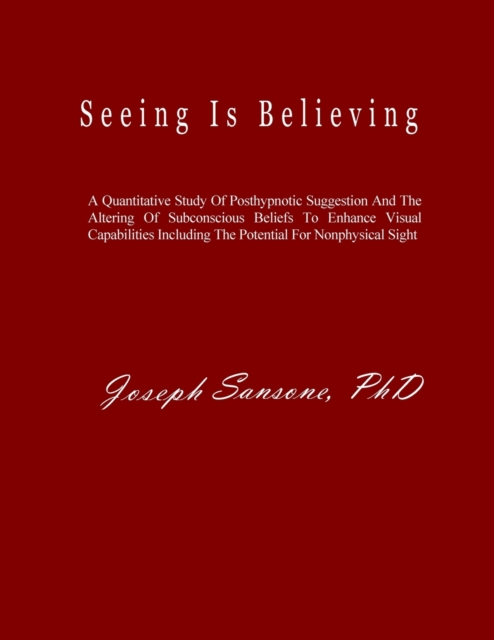
Seeing Is Believing : A Quantitative Study Of Posthypnotic Suggestion And The Altering Of Subconscious Beliefs To Enhance Visual Capabilities Including The Potential For Nonphysical Sight Paperback / softback
by Joseph Sansone
Paperback / softback
Description
This quantitative study used posthypnotic suggestion to measure for improvements in visual capabilities utilizing standard eye charts. Participants’ vision was tested prior to hypnosis with a standard eye chart adjacent to participants. Participants were hypnotized and given a posthypnotic suggestion to enhance vision. Participants’ vision was tested again using a different variation of a standard eye chart to measure for visual improvement. Participants were hypnotized again. While hypnotized, a dry-erase board was placed in front of a single-line eye chart of 5 letters, obstructing all lines of sight to the eye chart. Participants were given a posthypnotic suggestion inducing a negative hallucination rendering the dry-erase whiteboard that was obstructing the line of sight to the eye chart invisible, and were provided suggestions to see through or around the obstruction. Conscious amnesia of the posthypnotic suggestion was embedded in the suggestion rendering the negative hallucination of the object of obstruction unavailable to conscious awareness. Participants were then tested again using a single-line eye chart of 5 letters. A total of 50 participants were selected for the study on visual enhancement and a subset of 5 participants capable of a negative hallucination were tested to explore the potential for nonphysical sight. Participants were debriefed that deception was used in the experiment. Results were statistically significant for eyesight improvement. Results were also statistically significant for evidence of nonphysical sight, although considered preliminary due to a small sample size. Implications of the findings are discussed.
Information
-
Out of stock
- Format:Paperback / softback
- Pages:122 pages, Illustrations
- Publisher:High Energy Publishing LLC
- Publication Date:14/11/2019
- Category:
- ISBN:9780578595573
Information
-
Out of stock
- Format:Paperback / softback
- Pages:122 pages, Illustrations
- Publisher:High Energy Publishing LLC
- Publication Date:14/11/2019
- Category:
- ISBN:9780578595573






